Shock tube facility


The shock tube facility operated by the German Aerospace Center (Deutsches Zentrum für Luft- und Raumfahrt; DLR) DLR-Institute of Combustion Technology in Stuttgart enables ignitable gaseous mixtures to be heated and compressed to combustion-relevant temperatures and pressures in microseconds. This large-scale research facility is used to develop and validate chemical kinetic reaction mechanisms that are used, among other purposes, to simulate combustion processes in gas turbines, furnaces and rocket combustion chambers.
The large-scale facility incorporates three shock tubes and the associated diagnostic and chemical-analytical infrastructure. The individual shock tubes are dedicated to different tasks and equipped accordingly. When ignitable mixtures are provided by the system, the boundary conditions under which, for example, combustible fuel and propellant mixtures ignite, and the point in time from which these conditions prevail, are optimally defined. These can be set to remain constant over a period of a few milliseconds, up until the point at which the mixture self-ignites. Moreover, product distributions of stable species can be measured and the development of individual reactions over time can be traced by measuring the absorption of specific radicals.
Extreme mixture ratios and their combustion properties
The ignition delay times determined in the shock wave system characterise the chemical kinetic reaction system subject to temperature, pressure and fuel-oxidiser ratios. It can also be used to test extreme mixing ratios and conditions that cannot be achieved in a normal technical combustion system, but which are relevant to the design. Product distributions, on the other hand, represent a state of the reaction system that was ‘frozen’ after a defined period of time.
The data obtained are instrumental in the development and validation of chemical kinetic reaction mechanisms (combustion models) that are used to simulate combustion processes in gas turbines, furnaces and rocket combustion chambers, among other purposes. In these computational fluid dynamics (CFD) simulations, design parameters such as fuel flexibility, low-pollution combustion, extinguishing limits and thermoacoustics are key for the simulation of which a combustion model adapted to the respective conditions must be derived. In addition, real and complex fuels and their mixtures can be compared directly in terms of their characteristic combustion properties; this enables scientists to draw conclusions about their combustion behaviour in a pre-existing process.
